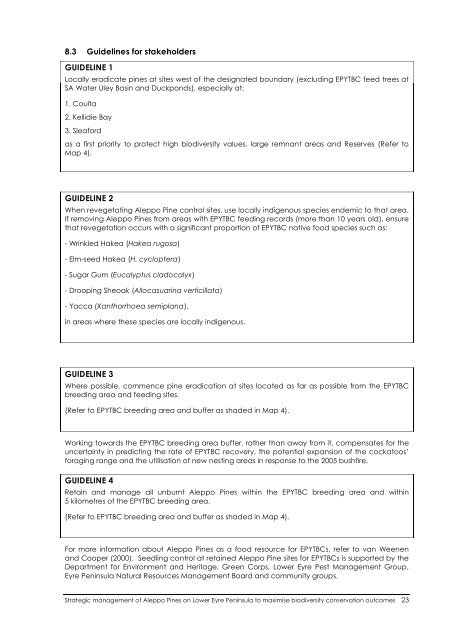Strategic management of Aleppo Pines on Lower Eyre
Strategic management of Aleppo Pines on Lower Eyre
Strategic management of Aleppo Pines on Lower Eyre
You also want an ePaper? Increase the reach of your titles
YUMPU automatically turns print PDFs into web optimized ePapers that Google loves.
8.3 Guidelines for stakeholders<br />
GUIDELINE 1<br />
Locally eradicate pines at sites west <str<strong>on</strong>g>of</str<strong>on</strong>g> the designated boundary (excluding EPYTBC feed trees at<br />
SA Water Uley Basin and Duckp<strong>on</strong>ds), especially at:<br />
1. Coulta<br />
2. Kellidie Bay<br />
3. Sleaford<br />
as a first priority to protect high biodiversity values, large remnant areas and Reserves (Refer to<br />
Map 4).<br />
GUIDELINE 2<br />
When revegetating <str<strong>on</strong>g>Aleppo</str<strong>on</strong>g> Pine c<strong>on</strong>trol sites, use locally indigenous species endemic to that area.<br />
If removing <str<strong>on</strong>g>Aleppo</str<strong>on</strong>g> <str<strong>on</strong>g>Pines</str<strong>on</strong>g> from areas with EPYTBC feeding records (more than 10 years old), ensure<br />
that revegetati<strong>on</strong> occurs with a significant proporti<strong>on</strong> <str<strong>on</strong>g>of</str<strong>on</strong>g> EPYTBC native food species such as:<br />
- Wrinkled Hakea (Hakea rugosa)<br />
- Elm-seed Hakea (H. cycloptera)<br />
- Sugar Gum (Eucalyptus cladocalyx)<br />
- Drooping Sheoak (Allocasuarina verticillata)<br />
- Yacca (Xanthorrhoea semiplana),<br />
in areas where these species are locally indigenous.<br />
GUIDELINE 3<br />
Where possible, commence pine eradicati<strong>on</strong> at sites located as far as possible from the EPYTBC<br />
breeding area and feeding sites.<br />
(Refer to EPYTBC breeding area and buffer as shaded in Map 4).<br />
Working towards the EPYTBC breeding area buffer, rather than away from it, compensates for the<br />
uncertainty in predicting the rate <str<strong>on</strong>g>of</str<strong>on</strong>g> EPYTBC recovery, the potential expansi<strong>on</strong> <str<strong>on</strong>g>of</str<strong>on</strong>g> the cockatoos’<br />
foraging range and the utilisati<strong>on</strong> <str<strong>on</strong>g>of</str<strong>on</strong>g> new nesting areas in resp<strong>on</strong>se to the 2005 bushfire.<br />
GUIDELINE 4<br />
Retain and manage all unburnt <str<strong>on</strong>g>Aleppo</str<strong>on</strong>g> <str<strong>on</strong>g>Pines</str<strong>on</strong>g> within the EPYTBC breeding area and within<br />
5 kilometres <str<strong>on</strong>g>of</str<strong>on</strong>g> the EPYTBC breeding area.<br />
(Refer to EPYTBC breeding area and buffer as shaded in Map 4).<br />
For more informati<strong>on</strong> about <str<strong>on</strong>g>Aleppo</str<strong>on</strong>g> <str<strong>on</strong>g>Pines</str<strong>on</strong>g> as a food resource for EPYTBCs, refer to van Weenen<br />
and Cooper (2000). Seedling c<strong>on</strong>trol at retained <str<strong>on</strong>g>Aleppo</str<strong>on</strong>g> Pine sites for EPYTBCs is supported by the<br />
Department for Envir<strong>on</strong>ment and Heritage, Green Corps, <strong>Lower</strong> <strong>Eyre</strong> Pest Management Group,<br />
<strong>Eyre</strong> Peninsula Natural Resources Management Board and community groups.<br />
<str<strong>on</strong>g>Strategic</str<strong>on</strong>g> <str<strong>on</strong>g>management</str<strong>on</strong>g> <str<strong>on</strong>g>of</str<strong>on</strong>g> <str<strong>on</strong>g>Aleppo</str<strong>on</strong>g> <str<strong>on</strong>g>Pines</str<strong>on</strong>g> <strong>on</strong> <strong>Lower</strong> <strong>Eyre</strong> Peninsula to maximise biodiversity c<strong>on</strong>servati<strong>on</strong> outcomes 23

















